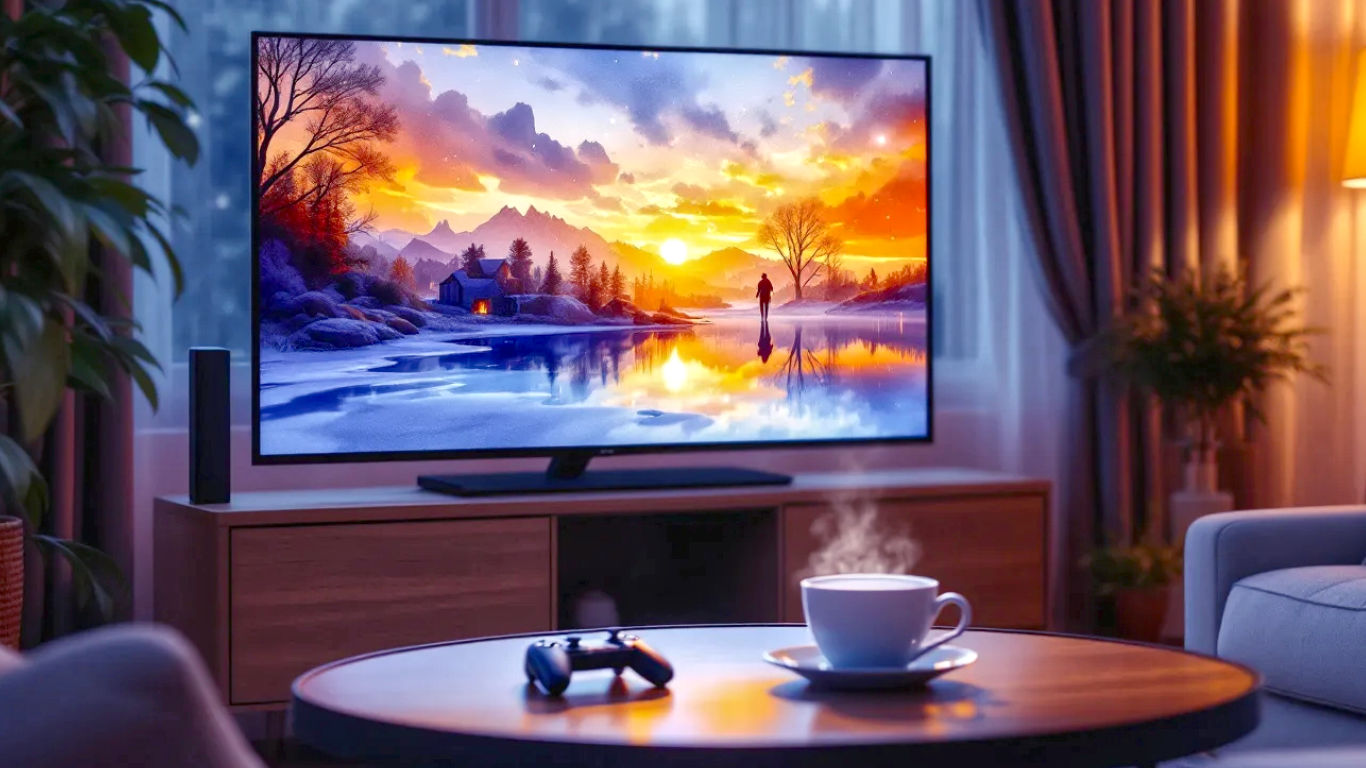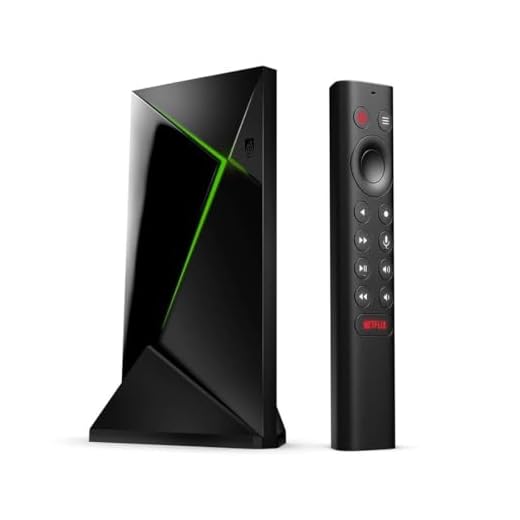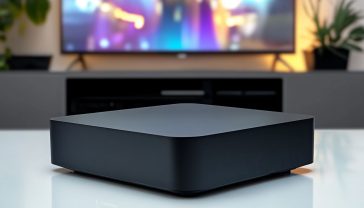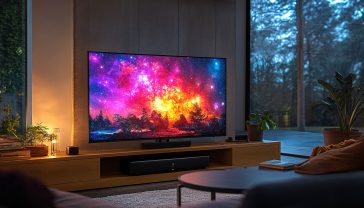NVIDIA Shield TV Pro: The Ultimate UK Entertainment Hub or Overhyped Streamer?
Is the NVIDIA Shield TV Pro the king of streamers or just hype? Our deep-dive review for UK users covers 4K streaming, AI upscaling, and cloud gaming.

This post may contain affiliate links. If you make a purchase through these links, we may earn a commission at no additional cost to you.
Picture this: it’s a drizzly Saturday night. The takeaway is on its way, you’ve got your feet up, and the telly is on. For years, that meant faffing about with a clunky Sky box, a noisy old PlayStation, or a streaming stick that buffers every time someone boils the kettle. It was… fine. But what if it could be better? What if one little black box could stream Netflix in stunning 4K and play top-tier video games from the cloud, manage your smart home, and breathe new life into your old film collection?
That’s the promise of the NVIDIA Shield TV Pro. On paper, it’s the undisputed king of streaming devices—a powerhouse packed with more tech than a James Bond gadget. But in a world of cheap-as-chips Amazon Fire Sticks and slick Apple TVs, is this premium streamer really worth the extra cash? Is it the ultimate entertainment hub for the modern British living room, or just an overhyped gadget for tech geeks?
Let’s be honest, we Brits love our telly. From EastEnders and Corrie to the latest David Attenborough documentary, it’s a cornerstone of our culture. So, a device claiming to be the best way to watch it all has a lot to live up to. In this guide, we’re going to pull the NVIDIA Shield TV Pro apart (not literally!) to see what makes it tick. We’ll cover everything from its powerful brain and clever AI tricks to how it handles everything from BBC iPlayer to high-end PC gaming. By the end, you’ll know for certain whether this is the upgrade your entertainment setup has been crying out for.
What Exactly Is the NVIDIA Shield TV Pro?
Before we dive into the nitty-gritty, let’s clear up what we’re talking about. The NVIDIA Shield TV Pro isn’t just another streaming stick you plug into the back of your TV. Think of it less like a Chromecast and more like a supercharged computer that’s been squashed into a sleek, unassuming box designed purely for your entertainment.
NVIDIA SHIELD Android TV Pro Streaming Media Player; 4K HDR Movies, Live Sports, Dolby Vision-Atmos, AI-Enhanced…
-
Powered by the advanced NVIDIA Tegra X1+ processor, delivering up to 25% faster performance than the previous generation.
-
Creates a cinematic experience on your TV with the combination of Dolby Vision HDR for picture and Dolby Atmos for sound.
-
Intelligently upscales HD video to 4K resolution in real-time using the power of AI for a sharper, clearer image.
-
Offers access to a vast library of 4K HDR entertainment, ensuring you can watch your favorite content in the highest possible quality.
-
The SHIELD Stand is sold separately to complete your setup.
At its heart, it’s an Android TV device. This means it runs on a version of the same software that powers millions of smartphones, but it’s been specifically designed for the big screen. You get access to the Google Play Store, so you can download thousands of apps like Netflix, Disney+, Prime Video, BBC iPlayer, ITVX, and All 4—all the usual suspects are here.
But that’s where the similarities with other streamers end. NVIDIA, the company that makes the Shield, is famous for creating powerful graphics cards for gaming PCs. They’ve squeezed that same DNA into the Shield. It has a custom-built processor called the Tegra X1+, which is an absolute beast compared to the chips inside most other streaming devices.
This extra muscle allows the Shield TV Pro to do three things exceptionally well:
- Deliver the highest quality streaming possible: It handles 4K resolution, HDR (High Dynamic Range for better colours), and advanced sound formats like Dolby Atmos without breaking a sweat.
- Run powerful AI Upscaling: This is its secret weapon. It uses artificial intelligence to make older, lower-resolution content (like that classic episode of Fawlty Towers or a DVD you ripped years ago) look sharper and clearer on your modern 4K TV.
- Act as a serious gaming machine: It can play advanced games downloaded from the Android store and, more importantly, stream blockbuster PC games directly from the cloud using NVIDIA’s GeForce NOW service.
It also comes with a distinctive Toblerone-shaped remote, plenty of ports to connect things like external hard drives, and a reputation as the go-to device for home cinema enthusiasts who want total control. In short, it’s built for performance, not just for passively watching The Great British Bake Off.
A Quick Trip Down Memory Lane: The Shield’s History
The Shield brand wasn’t always about a little black box for your telly. NVIDIA first launched the “NVIDIA Shield Portable” way back in 2013. It was a quirky handheld gaming device that looked like an Xbox controller with a screen attached. It was clever but didn’t exactly set the world on fire.
Then, in 2015, the first Shield Android TV arrived. It was a bold move. At the time, streaming was dominated by basic sticks. The Shield was big, powerful, and expensive. It was aimed squarely at people who wanted more—gamers, tech lovers, and home cinema buffs. It quickly earned a cult following for being the only device that could do everything.
The model we have today, the 2019 Shield TV Pro, is the third generation. It kept the same powerful Tegra X1+ chip but refined the design and introduced that game-changing AI upscaling. While other tech gadgets become obsolete after a couple of years, NVIDIA has done a fantastic job of keeping even the original 2015 model updated with the latest software. This commitment has built a huge amount of trust and loyalty among its users—a rare thing in the fast-moving world of tech.
The Main Event: What Can the Shield TV Pro Actually Do?
Alright, let’s get to the good stuff. What does this box do that your TV’s built-in smart apps or your £50 Fire Stick can’t? It comes down to power, flexibility, and a few killer features you won’t find anywhere else.
1. The Ultimate Streaming Machine: Picture and Sound Quality
If you’ve invested in a decent 4K HDR television, you want to feed it the best possible signal. The Shield TV Pro is designed to do exactly that.
AI Upscaling: The Magic Wand for Your Old Favourites
This is, without a doubt, the Shield’s headline feature. Let’s break it down.
- Simplified Explanation: Imagine you have an old, slightly blurry photo. AI upscaling is like having a clever artist look at that photo and intelligently draw in the missing details, making it look sharp and clear without just stretching it. The Shield does this in real-time for video. It takes a standard HD video (like from BBC iPlayer or an old Blu-ray) and uses its powerful brain to predict what it would look like in 4K, adding detail and enhancing edges.
- Detailed Explanation: The Tegra X1+ processor uses a neural network model trained by NVIDIA. This model has analysed thousands of hours of video to learn how to accurately enhance lower-resolution images. When you play a 720p or 1080p video, the chip intercepts the video frames, runs them through this AI model, and outputs a 4K signal to your TV. It offers several levels of enhancement (Low, Medium, High) so you can tailor the effect. It’s particularly effective on content from 720p up to 1080p, sharpening everything from live sports on Now TV to classic films on Netflix.
The result? It’s genuinely impressive. While it can’t perform miracles on really poor-quality old videos, it makes a noticeable difference. Programmes on iPlayer look crisper, YouTube videos pop with more detail, and even your own digital movie files look like they’ve had a professional remaster. No other streaming device on the market has anything close to this feature.
Full-Fat Audio and Video Support
For home cinema fans, this is crucial. Many cheaper streaming devices cut corners when it comes to supporting the latest and greatest audio-visual formats. The Shield TV Pro doesn’t.
It supports:
- 4K HDR: Including HDR10 and the more advanced Dolby Vision, which adjusts the picture scene-by-scene for the best possible image.
- Immersive Audio: It can pass through high-end audio formats like Dolby Atmos and DTS:X. If you have a soundbar or AV receiver that supports these, the Shield will let you experience sound that comes from all around you, even from above. This is a big deal, as many built-in TV apps and cheaper sticks can’t handle these formats properly, especially from apps like Plex or Kodi.
This means that whether you’re watching a blockbuster on Disney+ with Dolby Vision and Atmos, or playing a high-quality movie file from your own collection, the Shield ensures you’re getting the absolute best picture and sound your gear can deliver.
2. A Gateway to a Universe of Gaming
This is NVIDIA’s home turf, and it shows. The Shield TV Pro is arguably the best and most versatile games console that isn’t actually a console.
GeForce NOW: Cloud Gaming Done Right
This is the future of gaming, and the Shield is the best way to experience it today.
- Simplified Explanation: Imagine Netflix, but for video games. Instead of the game running on a console in your living room, it’s running on a super-powerful NVIDIA computer in a data centre somewhere in London or Dublin. The video of the game is then streamed to your Shield, and your controller commands are sent back instantly. You get to play the latest, most demanding PC games on your TV with the graphics turned up to max, without needing a £2,000 gaming PC.
- Detailed Explanation: GeForce NOW connects to your existing game libraries on platforms like Steam, Epic Games, and Ubisoft Connect. You don’t have to re-buy your games. There’s a free tier that lets you play for an hour at a time, but the real magic happens with the paid ‘Priority’ and ‘Ultimate’ tiers. The Ultimate tier gives you access to a virtual PC with an RTX 4080 graphics card, streaming at up to 4K resolution at 120 frames per second with ray tracing. The latency (the delay between pressing a button and seeing the result) is incredibly low, especially with a good broadband connection. For most people in the UK with decent fibre, it feels just like playing on a local console.
You can connect an Xbox, PlayStation, or the official Shield controller and jump into titles like Cyberpunk 2077, Baldur’s Gate 3, or Alan Wake 2 with graphics that an Xbox Series X or PS5 would struggle to match. It’s a genuine game-changer.
Android Gaming and Emulation
The powerful Tegra X1+ chip also means the Shield is a fantastic device for running high-end Android games from the Google Play Store. But for retro gaming fans, its real strength is emulation. It has enough power to emulate classic consoles from the SNES and Mega Drive right up to the GameCube and Dreamcast, running them perfectly. With a connected hard drive full of your old (and legally backed-up!) games, the Shield can become the ultimate retro gaming station.
3. The Plex and Kodi Powerhouse
For those who have their own collection of digital movies, TV shows, and music, the Shield TV Pro is the undisputed champion. This is thanks to its power and its ports.
Many people use apps like Plex or Kodi to organise and play their own media files. The Shield TV Pro can act as both the player (the client) and the server.
- Running as a Plex Media Server: This is a huge advantage. You can plug a large USB hard drive full of your media directly into one of the Shield’s USB 3.0 ports. You can then install the Plex Media Server app on the Shield itself. The device is powerful enough to run the server 24/7, organising your library and even streaming it to other devices in your home (or on your phone when you’re out and about). Using a dedicated streaming box as a server is something no Fire Stick or Apple TV can do. It saves you from having to leave a power-hungry PC or a separate network drive running all the time.
- Flawless Playback: When it comes to playing media, the Shield can handle pretty much any file format you throw at it. It can ‘direct play’ massive, high-bitrate 4K Blu-ray rips with complex Dolby Atmos audio tracks without stuttering. Cheaper devices often struggle with these large files and have to ‘transcode’ them (convert them on the fly), which can reduce quality. With the Shield, you just get perfect, uncompromised playback.
4. Smart Home Hub and Customisation
Because it runs on Android TV, the Shield is deeply integrated with the Google ecosystem.
- Google Assistant: The remote has a dedicated button for Google Assistant. You can use your voice to search for films (“Show me films starring Tom Hardy”), ask questions (“What’s the weather like in Manchester?”), or control your smart home devices (“Dim the living room lights”).
- Chromecast Built-in: You can easily ‘cast’ content from your phone or laptop directly to the Shield, just like a regular Chromecast.
- Endless Customisation: Being an Android device, it’s incredibly open. You can customise the home screen, ‘sideload’ apps that aren’t on the Google Play Store, and tinker to your heart’s content. It’s a tinkerer’s dream, but it’s also perfectly simple to use straight out of the box if you don’t want to mess with it.
The Hardware: A Closer Look at the Box and the Remote
Let’s talk about the physical bits and pieces. What do you get for your money?
The Shield TV Pro Box
The device itself is surprisingly compact and has a sleek, angular design that looks quite futuristic without being obnoxious. It’s designed to be passively cooled, meaning there are no fans, so it’s completely silent—a massive plus for any living room setup.
Crucially, it has excellent connectivity:
- Two USB 3.0 Ports: Essential for connecting external hard drives, keyboards, or other accessories. This is a major feature missing from most of the competition.
- HDMI 2.0 Port: The standard for connecting to your 4K TV.
- Gigabit Ethernet Port: While it has fast Wi-Fi, for the best and most stable performance, especially for 4K streaming and GeForce NOW, plugging it directly into your router with an Ethernet cable is the way to go.
It also has 16GB of internal storage, which is decent for apps, but you can easily expand this using a USB stick or by adopting a connected hard drive as internal storage.
The Famous (or Infamous) Toblerone Remote
The 2019 remote was a big upgrade over previous versions. It has a unique triangular prism shape that feels comfortable in the hand. The buttons are motion-activated and backlit, so they light up as soon as you pick it up in a dark room—a brilliant touch.
It has all the essential buttons: a directional pad, home, back, Google Assistant, and a volume rocker. It also has a dedicated Netflix button (of course) and a customisable menu button that you can program to do whatever you want, like open a specific app or mute the sound.
One of the cleverest features is the remote finder. If you lose it down the side of the sofa, you can press a button on the Shield box (or use the Shield app on your phone), and the remote will start beeping. It’s a marriage-saver.
The Shield TV Pro vs. The Competition: A UK Showdown
So, the Shield is powerful. But it also costs around £190. A 4K Amazon Fire TV Stick costs about £60, and an Apple TV 4K is about £150. How does it stack up?
| Feature | NVIDIA Shield TV Pro | Apple TV 4K | Amazon Fire TV Stick 4K Max | Google Chromecast with Google TV |
|---|---|---|---|---|
| Processor | Tegra X1+ (Very Powerful) | A15 Bionic (Very Powerful) | MediaTek MT8696T (Good) | Amlogic S905X3 (Okay) |
| AI Upscaling | Yes (Excellent) | No | No | No |
| Cloud Gaming | GeForce NOW (Best in class) | Apple Arcade (Good, but mobile-focused) | Amazon Luna (Limited in UK) | Stadia (Defunct) |
| Plex/Kodi Server | Yes (Excellent) | No | No | No |
| USB Ports | Yes (2x USB 3.0) | No | No (requires adapter) | No (requires adapter) |
| Lossless Audio | Yes (Dolby TrueHD, DTS-HD MA) | Yes (Limited app support) | No | No |
| UK Catch-up Apps | iPlayer, ITVX, All 4, My5 | iPlayer, ITVX, All 4, My5 | iPlayer, ITVX, All 4, My5 | iPlayer, ITVX, All 4, My5 |
| Customisation | Very High (Android TV) | Low (tvOS) | Medium (Fire OS) | High (Google TV) |
Shield TV Pro vs. Apple TV 4K
This is the closest fight. The Apple TV 4K is also a very powerful, premium device. It’s incredibly slick, fast, and integrates perfectly if you’re already in the Apple ecosystem (iPhones, iPads, etc.). The interface is clean and simple.
- Choose the Apple TV 4K if: You love Apple’s simplicity, use other Apple devices, and mainly want a fast, reliable box for streaming apps like Netflix and Disney+.
- Choose the Shield TV Pro if: You want AI upscaling, the best cloud gaming via GeForce NOW, the ability to run a Plex server, or the flexibility to play your own media files without hassle. It’s the choice for power users and home cinema enthusiasts.
Shield TV Pro vs. Amazon Fire TV Stick 4K Max
The Fire Stick offers incredible value for money. It does the basics of 4K HDR streaming very well, supports most of the main apps, and the Alexa voice remote is excellent.
- Choose the Fire TV Stick if: You’re on a budget and just want a simple, effective way to watch the main streaming services in good quality.
- Choose the Shield TV Pro if: You find the Fire Stick a bit slow, are frustrated by its limited audio support, or want any of the Shield’s advanced features like gaming, upscaling, or serving your own media. The performance gap is enormous.
The Downsides: Are There Any Catches?
No device is perfect, and the Shield TV Pro is no exception. There are a few things to be aware of.
- The Price: It’s the most obvious one. At nearly £200, it’s a significant investment compared to the competition. You have to really want its unique features to justify the cost.
- The Age of the Chip: While the Tegra X1+ is still incredibly capable, it’s based on a design that’s been around since 2015. This means it lacks support for a couple of newer technologies, most notably the AV1 video codec. YouTube and Netflix are starting to use AV1 to stream 4K video more efficiently. The Shield can’t decode this in hardware, meaning it has to do it in software, which can sometimes lead to dropped frames. It’s not a huge problem right now, but it’s a slight knock against its future-proofing.
- Android TV Can Be a Bit Busy: The standard Android TV home screen is now quite cluttered with recommendations and adverts. It’s not as clean as Apple’s interface. However, the beauty of Android is that you can install a custom ‘launcher’ to make the home screen look exactly how you want it.
The Verdict: Is the NVIDIA Shield TV Pro Worth It for a British Audience in 2025?
After all that, we come back to our original question. Is the NVIDIA Shield TV Pro the ultimate entertainment hub or an overhyped streamer?
The answer is, it’s genuinely the ultimate entertainment hub, but only if you’ll use its power.
Think of it like buying a Land Rover Defender. If all you do is drive to the local Tesco, it’s overkill. It’s big, expensive, and a Ford Fiesta would do the job just fine. But if you need to tow a horsebox, drive across a muddy field, and rely on it to start every time in the middle of nowhere, then its power and capability make it worth every penny.
It’s the same with the Shield.
You should absolutely buy the NVIDIA Shield TV Pro if:
- You are a home cinema enthusiast: You have a good 4K TV and sound system and want to guarantee you’re getting the absolute best picture and sound quality from every source, especially your own media files via Plex or Kodi.
- You are a serious gamer who doesn’t own a high-end PC: GeForce NOW on the Shield is a phenomenal and cost-effective way to play the biggest and best PC games on your main TV.
- You have a large library of older or HD content: The AI upscaling is a unique and brilliant feature that will make your existing collection look noticeably better on a 4K screen.
- You just want the fastest, most powerful, and most flexible streaming device money can buy and are fed up with the compromises of cheaper sticks.
You should probably save your money if:
- You just want to watch Netflix, iPlayer, and YouTube: A cheaper Chromecast or Fire Stick will do that job perfectly well for a fraction of the price.
- You are deeply invested in the Apple ecosystem: The seamless integration of the Apple TV 4K might be more appealing.
- You’re on a tight budget: The high asking price is hard to ignore if you won’t be using the Pro features.
Ultimately, the NVIDIA Shield TV Pro remains in a class of its own. Years after its release, there is still no other single device that can do everything it does so well. It streams, it games, it serves, it upscales, and it tinkers. It’s not just a streamer; it’s the brain of a modern, high-performance entertainment setup. For the right user, it’s not overhyped at all—it’s an essential purchase and the undisputed king of the living room.
Further Reading
For those looking to dive even deeper, these resources are highly recommended:
- AVForums: A fantastic UK-based forum with dedicated sections for streaming devices where you can find expert and user reviews.
- What Hi-Fi?: A trusted source for reviews on all things audio-visual, with detailed analysis of picture and sound quality.
- Plex’s Official Website: For detailed guides on setting up a Plex Media Server.
- NVIDIA’s Official GeForce NOW page: To check the latest game libraries and subscription details.







